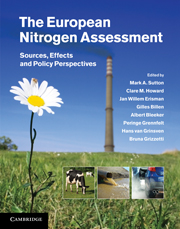Book contents
- Frontmatter
- Contents
- List of contributors
- Foreword
- Summary for policy makers
- Technical summary
- 1 Assessing our nitrogen inheritance
- Part I Nitrogen in Europe: the present position
- 2 The European nitrogen problem in a global perspective
- 3 Benefits of nitrogen for food, fibre and industrial production
- 4 Nitrogen in current European policies
- 5 The challenge to integrate nitrogen science and policies: the European Nitrogen Assessment approach
- Part II Nitrogen processing in the biosphere
- Part III Nitrogen flows and fate at multiple spatial scales
- Part IV Managing nitrogen in relation to key societal threats
- Part V European nitrogen policies and future challenges
- Glossary
- Index
- References
3 - Benefits of nitrogen for food, fibre and industrial production
from Part I - Nitrogen in Europe: the present position
Published online by Cambridge University Press: 16 May 2011
- Frontmatter
- Contents
- List of contributors
- Foreword
- Summary for policy makers
- Technical summary
- 1 Assessing our nitrogen inheritance
- Part I Nitrogen in Europe: the present position
- 2 The European nitrogen problem in a global perspective
- 3 Benefits of nitrogen for food, fibre and industrial production
- 4 Nitrogen in current European policies
- 5 The challenge to integrate nitrogen science and policies: the European Nitrogen Assessment approach
- Part II Nitrogen processing in the biosphere
- Part III Nitrogen flows and fate at multiple spatial scales
- Part IV Managing nitrogen in relation to key societal threats
- Part V European nitrogen policies and future challenges
- Glossary
- Index
- References
Summary
Executive summary
Nature of the issue
Reactive nitrogen (Nr) has well-documented positive effects in agricultural and industrial production systems, human nutrition and food security. Limited Nr supply was a key constraint to European food and industrial production, which has been overcome by Nr from the Haber–Bosch process.
Given the huge diversity in Nr uses, it becomes a major challenge to summarize an overall inventory of Nr benefits. This full list of benefits needs to be quantified if society is to develop sound approaches to optimize Nr management, balancing the benefits against the environmental threats.
Approaches
When reviewing trends in European Nr production rates, including those from chemical and biological fixation processes, and the consumption of this Nr in human activities, agriculture is by far the largest sector driving Nr creation.
Particular attention has been given to relationships between N application rates, productivity and quality of products from major crops and livestock types, including consideration of the mechanisms underlying variations in N response/outputs and the derived impacts on land use and land requirements.
Key findings/state of knowledge
The economic value of N benefits to the European economy is very substantial. Almost half of the global food can be produced because of Nr from the Haber–Bosch, and cereal yields in Europe without fertilizer would only amount to half to two-thirds of those with fertilizer application at economically optimal rates.
[…]
- Type
- Chapter
- Information
- The European Nitrogen AssessmentSources, Effects and Policy Perspectives, pp. 32 - 61Publisher: Cambridge University PressPrint publication year: 2011
References
- 30
- Cited by

